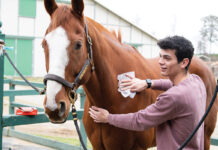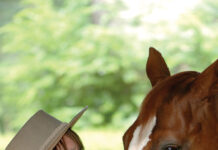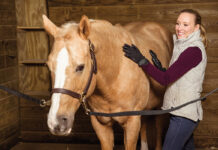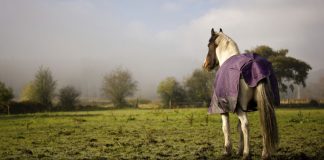There aren’t many people who truly enjoy body
clipping a horse. The monotonous droning of the clippers combined with the
airborne swirls of hair are enough to make anyone reconsider the project. Yet a
body clipped horse is easier to groom during the winter months. Sweat
evaporates more quickly from shorter hair, so a clipped horse is less likely to
catch a chill after a brisk ride. Plus, body clipping allows show horses to maintain
their prize-winning glow. And we can’t forget the equines afflicted with
Cushing’s disease. One of the side effects is a dense coat that doesn’t shed,
making body clipping a year-round procedure.
Fortunately, there are ways to make the chore more pleasant. Here are 10 tips that
will help you be prepared, and then keep both you and your horse comfortable
until the last blade stroke.
Wait until your horse’s winter coat has
fully grown in before you body clip.Otherwise, that sleek coat may be marred
by patches of late-blooming fuzz. Remember that it’s the shorter days of autumn
that stimulate the growth of more hair. That’s why you start seeing shaggy
horses at the end of daylight saving time.Choose clippers specifically labeled for body
clipping.Then, compare brands based on strokes per minute (spm), which is how
fast the blades move. This is important, since you can only move the clippers
as fast as the blades will cut the hair. Make sure your blades are sharp, and
keep a spare set of blades handy. Have your blades professionally sharpened
after every few body-clipping jobs. Also check the power of the motor, which is
measured in either watts or horsepower. A strong motor is less likely to
overheat in the middle of a clipping job.Have the necessary accessories assembled.
A small
but sturdy mounting block or step stool will help you reach the high points of
your horse’s body. Products like blade wash and cooling lubricants can help
your clippers run smoothly. But your most important accessory is clipper oil. About
every 15 minutes apply oil along the blades and put a few drops into the
clippers where noted in the manufacturer’s instructions. If your clippers have
an exterior filter, remove accumulated hair at this time, too.Enlist the help of a knowledgeable handler.
Even
if your horse typically stands patiently in the cross-ties or at the hitching
post, you can’t predict how he’ll behave during the lengthy process of body
clipping. Your handler should be adept at using a stud chain and a twitch
properly and humanely if it becomes necessary.Dress for the job.
You can minimize the amount of
horse hair that ends up in peculiar places by wearing a long-sleeved shirt or
jacket. Avoid fleece or other materials that hair will stick to easily. Also
consider wearing a bandana or ball cap on your head and a pair of safety
glasses to shield your eyes. Many professional body clippers also wear
disposable face masks so they don’t inhale fumes, hair, scurf and dander.If the weather allows it, thoroughly bathe your
horse with a good shampoo before clipping.As he dries, spritz his entire body,
including his legs, with a coat polish. That will repel dust and also help the
clipper blades glide over the hair. Let his coat dry completely before you
clip. Are you clipping the next day? Then cover your horse with a daysheet
overnight so he doesn’t greet you in the morning with manure stains.Before starting, introduce your horse to the body
clippers.They sound much louder than the ones you use to trim his whiskers and
fetlocks, so he may react with suspicion. Have your handler hold him while you
stand a few feet away with the clippers running. Approach your horse in a
matter-of-fact manner. If he tries to bolt, back away, but do not turn off the
clippers. When your horse is no longer anxious, make contact with the clippers
in a non-threatening area, like his shoulder or along his rib cage. Be
persistent, and pat him enthusiastically for behaving. Check your blades
frequently to make sure they haven’t become hot to the touch, causing an
uncomfortable experience for your horse. If he’s used to having his whiskers
and fetlocks trimmed, he should accept the body clippers once he understands
the concept.Use a smaller, quieter set of clippers for areas
where your horse is sensitive.Since they’re lighter in weight and easier to
maneuver, use them for clipping your horse’s legs (including the bumpy hocks
and knees) and face. Be sure the blade number corresponds with those on the
body clippers, or your horse could end up with a patchwork appearance. Typically,
No. 10 blades are used for body clipping.Always clip against the growth pattern of the hair,
including tricky whorls and cowlicks.Keep even, consistent pressure on the
clippers so that you don’t create a cobblestone pattern. Also make sure you
hold the blades flat against the skin so you don’t end up with lines. Dirty
blades or a dirty horse can also cause lines. Address those issues by rinsing
with blade wash, then oiling the blades and spot cleaning your horse with a
damp towel. Re-clip the troublesome areas in a criss-cross pattern, going back
and forth, across the lines and uneven patches.Pay attention to your horse’s demeanor.
If he
begins to flinch or gets grumpy, check your equipment. Have your clippers
gotten hot? Or has he simply gotten stressed or bored? Have your handler take
him back to his stall or corral for a drink and a potty break. That’ll also
give you a chance to relax for a moment before finishing the job.
When you stand back to admire your work, you might
notice some hives on your horse. These are usually caused by irritation from
the blades or oil. To soothe this temporary reaction and also banish any cut
hair that’s left behind, rinse your horse thoroughly. If it’s cold, opt for a
sponge bath using a bucket of warm water and rub him dry with a clean towel.
Throw on a cooler and keep him out of drafts until he’s dry. Then blanket him
properly according to your climate and whether he’ll be living inside or
outdoors. You’re now responsible for keeping him cozy, but in return you’ve
gotten rid of his winter woolies and transformed him from shaggy to sleek.
Liked this article? Here are others on clipping:
Body Clipping Secrets
HorseChannel’s Guide to Clipping Your Horse
Fun Horse Clipping Patterns






I live where it is very cold, and I do not think body clipping would work. I can see where it would benifit Cushing horses, but just for showing??
Awesome! I love Horse Channel, also I need to start practicing body clips for an upcoming horse show =]
Sonds like lots of work, but worth it.
Great article! Thanks again; I had no clue how to do this before!
Is there a time when it becomes too cold to clip?